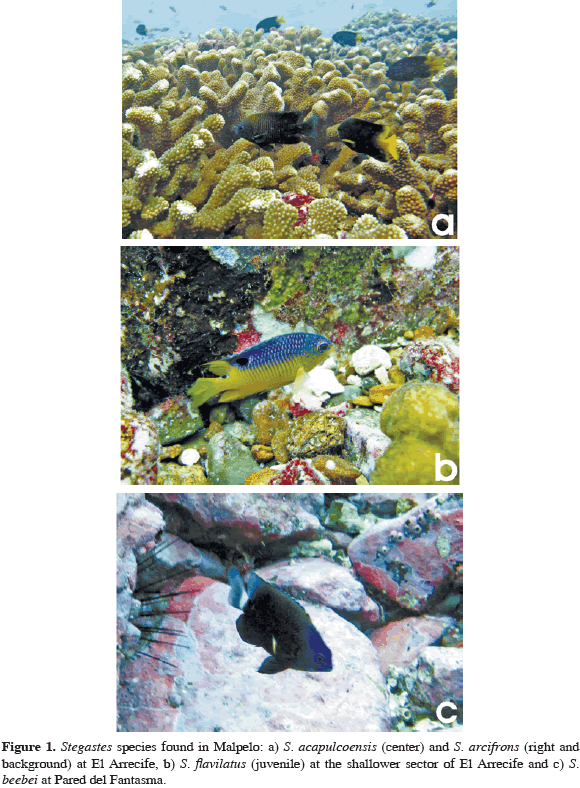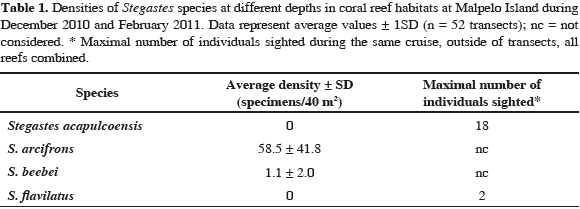Services on Demand
Journal
Article
Indicators
-
 Cited by SciELO
Cited by SciELO -
 Access statistics
Access statistics
Related links
-
 Cited by Google
Cited by Google -
 Similars in
SciELO
Similars in
SciELO -
 Similars in Google
Similars in Google
Share
Boletín de Investigaciones Marinas y Costeras - INVEMAR
Print version ISSN 0122-9761
Bol. Invest. Mar. Cost. vol.40 supl.1 Santa Marta Dec. 2011
NOTE:
FIRST RECORD OF THE BEAUBRUMMEL (STEGASTES FLAVILATUS) IN REEF HABITATS OF MALPELO ISLAND
PRIMER REGISTRO DE LA DAMISELA BICOLOR (STEGASTES FLAVILATUS) EN AMBIENTES ARRECIFALES DE LA ISLA MALPELO
Melina Rodríguez-Moreno1,2, Mateo López-Victoria3 and Fernando A. Zapata2
1 Excellence Center in Marine Sciences-CEMarin, Cr. 2 Nr. 11-68, El Rodadero, Santa Marta, Colombia, melinamoreno@hotmail.com.
2 Universidad del Valle, Department of Biology, Coral Reef Ecology Research Group, PO Box 25360, Cali, Colombia. fernando.zapata@correounivalle.edu.co.
3 Justus-Liebig University, Department of Animal Ecology, Heinrich-Buff-Ring 29, 35392, Giessen, Germany. gf1617@uni-giessen.de.
RESUMEN
El género Stegastes (familia Pomacentridae) tiene una distribución particular en el Pacífico Oriental Tropical, con dos especies ampliamente distribuidas en toda la región, y cinco especies restringidas a las islas oceánicas o al extremo boreal del trópico. Durante un estudio de las especies de este género presentes en ambientes arrecifales de la isla Malpelo, registramos, por primera vez para la isla, a Stegastes flavilatus. Esta es una especie rara en Malpelo, en donde S. arcifrons y S. beebei son dominantes. La cuarta especie presente en Malpelo, S. acapulcoensis, puede también considerarse como rara, aunque ligeramente más abundante que S. flavilatus.
PALABRAS CLAVE: Isla Malpelo, Peces, Pomacentridae, Primer registro, Stegastes flavilatus.
In the Tropical Eastern Pacific (TEP), the geographic distributions of damselfish species of the genus Stegastes (Pomacentridae) show an intriguing pattern (Allen and Woods, 1980): some species (e.g., S. acapulcoensis and S. flavilatus) are widely distributed over the entire region, primarily on continental coasts, while others (S. arcifrons, S. beebei, S. baldwini, S. leucorus and S. redemptus) are narrowly distributed, some of them restricted to the widely separated offshore islands in the region (Galapagos, Isla del Coco, Malpelo, and the Revillagigedos). These species show few morphological differences and share similar ecological and life history traits. They are highly territorial, have long adult life spans, are demersal spawners, and have high dispersal potential (Pelagic Larval Duration [PLD]: 23-30 days; Victor and Wellington, 2000; Meekan et al., 2001; Robertson and Allen, 2008). This note represents the first record of S. flavilatus for Malpelo and examines the current status of Stegastes species in reef habitats of Malpelo Island.
Malpelo (4°0'N, 81°36.5'W) is a volcanic island located 365 km from the nearest point on the American continental shore. It is small -about 1.2 km2 of emerged surface- with steep slopes and rocky shores all around. Some coral reef formations are located on the northern side of the island, and patches of corals and single colonies are unevenly distributed around the island between 1 and 30 m depth (Garzón-Ferreira and Pinzón, 1999).
To assess the population densities of the different Stegastes species present on coral reef formations of Malpelo, 52 belt transects (20 x 2 m), at different depths (5-30 m) and at different locations were conducted (El Arrecife, n = 23; Pared del Fantasma, n = 16; Pared del Náufrago, n = 9; La Nevera = 4). Censuses took place during two fieldtrips in December 2010 and February 2011. Additional presence/absence data of Stegastes species at different locations around Malpelo were collected during 32 additional dives (two observers, one hour each dive, both trips combined).
Four species of Stegastes are found at Malpelo (Figure 1). Of these, by far the most abundant in coral reef habitats is S. arcifrons, which in some locations reaches densities of up to 10 inds. m-2. The second most abundant species of Stegastes at Malpelo is S. beebei (Table 1). Stegastes acapulcoensis and S. flavilatus, none of which were recorded inside transects, can be considered rare since both their abundance and frequency of observation were very low (Table 1). The single record of S. flavilatus consisted of two juveniles located on the shallow portion of El Arrecife (8 m depth), sighted in December 2010. In February 2011 another juvenile was spotted in the same area (probably one of the two individuals sighted during the previous trip).
Previous authors have included species of Stegastes on their lists of the fish fauna from Malpelo, but none included S. flavilatus. The first list by McCosker and Rosenblatt (1975) included only S. arcifrons and S. beebei (both as Eupomacentrus). Subsequent lists (e.g. Prahl, 1990) reported one or both species (as Stegastes or Eupomacentrus), while Rubio et al. (1992) added S. acapulcoensis to the list of the fish fauna from the island. Finally, Rodríguez-Ramírez et al. (2007) compiled a list of the fish species recorded at El Arrecife, including S. beebei (as S. leucorus). To our knowledge, and considering the comprehensive work of Robertson and Allen (2008), ours is the first documented record of S. flavilatus for Malpelo Island.
ACKNOWLEDGEMENTS
Many thanks to the Colombian Environmental Ministry, in particular to the UAESPNN, and to the Malpelo Foundation for facilitating our research on Malpelo and for providing the corresponding permits. The Seascape Research Cruises provided us all the logistic support during the field trips. In this respect, many thanks to the crew of the vessels Nemo and Seawolf; D. Lozano and E. López kindly helped with the band transects during the fieldtrips.
LITERATURE CITED
1 Allen, G. R. and L. P. Woods. 1980. A review of the damselfish genus Stegastes from the Eastern Pacific with the description of a new species. Rec. West. Aust. Mus., 8: 171-198. [ Links ]
2 Garzón-Ferreira, J. and J. H. Pinzón. 1999. Evaluación rápida de estructura y salud de las formaciones coralinas de la isla de Malpelo. Bol. Invest. Mar. Cost., 28: 137-154. [ Links ]
3 McCosker, J. E. and R. H. Rosenblatt. 1975. Fishes collected at Malpelo Island. Smithsonian Contr. Zool., 176: 91-93. [ Links ]
4 Meekan, M. G., J. L. Ackerman and G. M. Wellington. 2001. Demography and age structures of coral reef damselfishes in the tropical eastern Pacific Ocean. Mar. Ecol. Prog. Ser., 212: 223-232. [ Links ]
5 Prahl, H. von. 1990. Malpelo la roca viviente. Fondo FEN Colombia. Ed. Presencia, Bogotá. 57 p. [ Links ]
6 Robertson, D. R. and G. R. Allen. 2008. Shorefishes of the Tropical Eastern Pacific online information system. Version 1.0. Smithsonian Tropical Research Institute, Balboa, Panamá. www.neotropicalfishes.org/sftep, www.stri.org/sftep. 15/07/2011. [ Links ]
7 Rodríguez-Ramírez, A., R. Navas-Camacho, M. C. Reyes-Nivia, S. Bejarano-Chavarro and J. Garzón- Ferreira. 2007. Implementación del SIMAC en la isla de Malpelo. 97-112. In: DIMAR-CCCP and UAESPNN-DTSO (Eds.). Santuario de Fauna y Flora Malpelo: descubrimiento en marcha. DIMAR, Bogotá. 142 p. [ Links ]
8 Rubio, E. A., A. Suárez, F. Estupiñán, W. Henao and B. Vargas. 1992. Los recursos ictiológicos de la Isla Malpelo (Colombia) I. Una revisión de su conocimiento y nuevos reportes para la ictiofauna de la isla. 642-658. En: CCO (Ed.). Memorias del VIII Seminario Nacional de las Ciencias y las Tecnologías del Mar y Congreso Centroamericano y del Caribe en Ciencias del Mar, Tomo II. Comisión Colombiana de Oceanografía, Santa Marta. 1144 p. [ Links ]
9 Victor, B. C. and G. M. Wellington. 2000. Endemism and the pelagic larval duration of reef fishes in the eastern Pacific Ocean. Mar. Ecol. Prog. Ser., 205: 241-248. [ Links ]
FECHA DE RECEPCIÓN: 08/03/2011 FECHA DE ACEPTACIÓN: 12/10/2011















